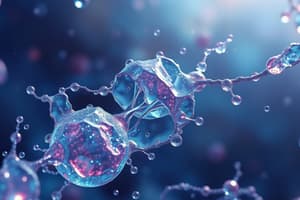Podcast
Questions and Answers
What characteristic defines a hydrophilic substance?
What characteristic defines a hydrophilic substance?
- It has an affinity for water. (correct)
- It repels water.
- It is always nonpolar.
- It can only dissolve in organic solvents.
What is the definition of molarity?
What is the definition of molarity?
- The number of moles of solute per liter of solution. (correct)
- The concentration of solute in grams per liter.
- The mass of solute per liter of solution.
- The volume of solute per volume of solution.
Which type of molecules can water dissolve according to their structure?
Which type of molecules can water dissolve according to their structure?
- Only large proteins.
- Only ionic compounds.
- Nonionic polar molecules with ionic regions. (correct)
- Nonpolar molecules like oil.
What is the significance of Avogadro’s number in chemistry?
What is the significance of Avogadro’s number in chemistry?
Why are oil molecules considered hydrophobic?
Why are oil molecules considered hydrophobic?
What is the heat of vaporization for water?
What is the heat of vaporization for water?
Why does ice float on liquid water?
Why does ice float on liquid water?
What is the process called when evaporation leads to cooling of the remaining liquid?
What is the process called when evaporation leads to cooling of the remaining liquid?
At what temperature does water reach its greatest density?
At what temperature does water reach its greatest density?
What term describes a liquid that is a homogeneous mixture of substances?
What term describes a liquid that is a homogeneous mixture of substances?
What surrounds each ion in a solution when an ionic compound is dissolved in water?
What surrounds each ion in a solution when an ionic compound is dissolved in water?
What characteristic of water makes it a versatile solvent?
What characteristic of water makes it a versatile solvent?
What would likely happen if ice did not float and sank in bodies of water?
What would likely happen if ice did not float and sank in bodies of water?
What property of water allows it to transport nutrients against gravity in plants?
What property of water allows it to transport nutrients against gravity in plants?
Which of the following is NOT an emergent property of water that supports life?
Which of the following is NOT an emergent property of water that supports life?
What is the significance of water's polarity?
What is the significance of water's polarity?
How does the ability of water to moderate temperature benefit life on Earth?
How does the ability of water to moderate temperature benefit life on Earth?
What phenomenon measures how hard it is to break the surface of water?
What phenomenon measures how hard it is to break the surface of water?
What role does adhesion play in plant water transport?
What role does adhesion play in plant water transport?
Why is water considered a versatile solvent?
Why is water considered a versatile solvent?
In terms of cellular composition, what is the approximate percentage of water found in most cells?
In terms of cellular composition, what is the approximate percentage of water found in most cells?
Which of the following substances is the most acidic?
Which of the following substances is the most acidic?
What is the pH level of pure water?
What is the pH level of pure water?
Which of these solutions is classified as basic?
Which of these solutions is classified as basic?
Buffers in biological systems primarily consist of what?
Buffers in biological systems primarily consist of what?
Which of the following has a pH level closest to that of human blood?
Which of the following has a pH level closest to that of human blood?
What characteristic does an acidic solution possess?
What characteristic does an acidic solution possess?
Which substance would most likely have a pH level of about 11?
Which substance would most likely have a pH level of about 11?
What role do buffers play in biological systems?
What role do buffers play in biological systems?
What happens to a water molecule when it loses a proton?
What happens to a water molecule when it loses a proton?
What is the relationship between hydrogen ion concentration and pH?
What is the relationship between hydrogen ion concentration and pH?
Which of the following statements about acids is true?
Which of the following statements about acids is true?
At 25°C, what is the product of H+ and OH– concentrations in a neutral solution?
At 25°C, what is the product of H+ and OH– concentrations in a neutral solution?
What is the pH of a solution with a hydrogen ion concentration of $10^{-6}$ M?
What is the pH of a solution with a hydrogen ion concentration of $10^{-6}$ M?
Which statement correctly defines a base?
Which statement correctly defines a base?
What is the typical pH range for most biological fluids?
What is the typical pH range for most biological fluids?
Which ion is often represented as H+ in aqueous solutions?
Which ion is often represented as H+ in aqueous solutions?
Flashcards are hidden until you start studying
Study Notes
Overview of Water's Importance
- Water is essential for all living organisms, serving as the primary biological medium on Earth.
- Cells consist of approximately 70-95% water, highlighting its critical role in biological functions.
- The abundance of water makes Earth habitable, supporting various life forms.
Water's Molecular Structure
- Water molecules are polar, possessing opposite charges at each end, facilitating hydrogen bonding.
- Hydrogen bonds result from the polarity of water, allowing water molecules to interact cohesively.
Emergent Properties of Water
- Key properties that make Earth suitable for life include:
- Cohesive behavior: Hydrogen bonds enable water molecules to stay together, aiding in water transport in plants.
- Temperature moderation: Water can absorb and release heat, helping to stabilize environmental temperatures.
- Expansion upon freezing: Ice is less dense than liquid water, allowing it to float and insulate bodies of water.
- Solvent versatility: Water is capable of dissolving a wide range of substances due to its polarity.
Cohesion and Adhesion
- Cohesion facilitates the upward movement of water in plants against gravity.
- Adhesion refers to the attraction between different substances, such as water and plant cell walls.
Surface Tension and Evaporation
- Water has high surface tension due to cohesive hydrogen bonds, which makes it difficult to break the surface of the liquid.
- Evaporation allows water to cool when the remaining liquid absorbs heat, a process known as evaporative cooling, vital for temperature regulation in organisms.
Ice's Unique Properties
- Ice floats because hydrogen bonds arrange molecules in a structured way, making it less dense than liquid water.
- Water is most dense at 4°C; if ice sank, aquatic ecosystems would freeze solid, threatening life.
Water as a Solvent
- In solutions, water acts as a solvent (dissolving agent) while solutes are the substances being dissolved.
- A hydration shell forms around ions when ionic compounds dissolve in water, facilitating ion distribution.
Hydrophilic and Hydrophobic Substances
- Hydrophilic substances are attracted to water, while hydrophobic substances repel water.
- Nonpolar molecules like oil are hydrophobic, indicating their lack of affinity for water.
Concentration and Chemical Reactions
- Most biochemical reactions occur in water, which is essential for molecular collisions.
- Molarity (M) measures dissolved substance concentration in solution, with one mole equaling 6.02 x 10²³ molecules.
Acids, Bases, and pH Scale
- Water can dissociate into H+ (hydrogen ion) and OH− (hydroxide ion), essential for acid-base chemistry.
- Acids increase H+ in a solution, while bases decrease H+ concentration.
- The pH scale quantifies acidity and basicity, with pure water having a neutral pH of 7.
Buffers and Cellular pH
- Cellular pH typically remains close to 7, critical for maintaining biochemical processes.
- Buffers are substances that stabilize pH by preventing drastic changes in H+ and OH– concentrations, usually comprising an acid-base pair.
Studying That Suits You
Use AI to generate personalized quizzes and flashcards to suit your learning preferences.



